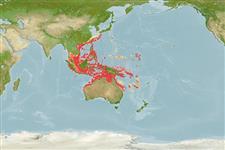Teleostei (teleosts) >
Eupercaria/misc (Various families in series Eupercaria) >
Lutjanidae (Snappers) > Paradicichthyinae
Etymology: Symphorus: Greek, syn, symphysis = grown together + Greek, physis = growth body form + Greek, oura = tail (Ref. 45335).
More on author: Bleeker.
Environment: milieu / climate zone / depth range / distribution range
Ecology
Marine; reef-associated; depth range 20 - 100 m (Ref. 57178). Tropical; 32°N - 26°S, 98°E - 170°E (Ref. 55)
Western Pacific: Ryukyu Islands to the Indo-Australian Archipelago (Malay Peninsula to New Guinea and northern Australia).
Size / Weight / Age
Maturity: Lm ? range ? - ? cm
Max length : 100.0 cm SL male/unsexed; (Ref. 9821); common length : 35.0 cm SL male/unsexed; (Ref. 9821); max. published weight: 13.2 kg (Ref. 40637)
Adults inhabit coral reefs, from shallow water to depths of at least 50 m. They occur singly. They feed mainly on fishes. Frequently ciguatoxic in certain areas. Sold in Hong Kong live fish markets (Ref. 27253). It causes ciguatera poisoning in some areas. Banned for sale in Australia. (Ref. 90102)
Life cycle and mating behavior
Maturities | Reproduction | Spawnings | Egg(s) | Fecundities | Larvae
Allen, G.R., 1985. FAO Species Catalogue. Vol. 6. Snappers of the world. An annotated and illustrated catalogue of lutjanid species known to date. FAO Fish. Synop. 125(6):208 p. Rome: FAO. (Ref. 55)
IUCN Red List Status (Ref. 130435)
Threat to humans
Reports of ciguatera poisoning (Ref. 4690)
Human uses
Fisheries: commercial; gamefish: yes
Tools
Special reports
Download XML
Internet sources
Estimates based on models
Preferred temperature (Ref.
123201): 24.2 - 28.4, mean 27.4 °C (based on 477 cells).
Phylogenetic diversity index (Ref.
82804): PD
50 = 1.0000 [Uniqueness, from 0.5 = low to 2.0 = high].
Bayesian length-weight: a=0.01202 (0.00475 - 0.03046), b=3.03 (2.81 - 3.25), in cm total length, based on LWR estimates for this (Sub)family-body shape (Ref.
93245).
Trophic level (Ref.
69278): 4.1 ±0.5 se; based on diet studies.
Generation time: 4.8 ( na - na) years. Estimated as median ln(3)/K based on 1
growth studies.
Resilience (Ref.
120179): Medium, minimum population doubling time 1.4 - 4.4 years (K=0.23).
Fishing Vulnerability (Ref.
59153): Moderate to high vulnerability (49 of 100).
Nutrients (Ref.
124155): Calcium = 24 [14, 41] mg/100g; Iron = 0.517 [0.276, 0.828] mg/100g; Protein = 19.1 [17.3, 20.8] %; Omega3 = 0.135 [0.089, 0.205] g/100g; Selenium = 44.5 [27.0, 78.4] μg/100g; VitaminA = 79.2 [29.1, 240.7] μg/100g; Zinc = 0.725 [0.518, 1.013] mg/100g (wet weight);
